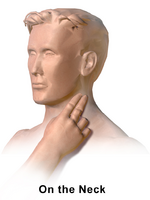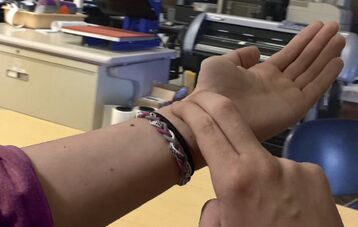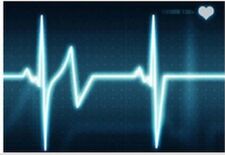Pulse Rate: Difference between revisions
No edit summary |
No edit summary |
||
| Line 5: | Line 5: | ||
== Introduction == | == Introduction == | ||
[[File:Pulse (Neck).png|thumb|200x200px|Pulse (Neck)]] | [[File:Pulse (Neck).png|thumb|200x200px|Figure. 1 Carotid Pulse (Neck)]] | ||
Pulse/[[Heart Rate|heart rate]] is the wave of [[blood]] in the [[Arteries|artery]] created by contraction of the [[Left Ventricle Heart|left ventricle]] during a cardiac cycle. The strength or amplitude of the pulse reflects the amount of blood ejected with [[Muscle: Cardiac|myocardial]] contraction (stroke volume). Normal pulse rate range for an adult is between '''60-100 beats per minute'''. A well-trained athlete may have a resting heart rate of 40 to 60 beats per minute, according to the [https://www.heart.org/ American Heart Association] (AHA).<ref>Live Science. What is normal heart rate? Available from: https://www.livescience.com/42081-normal-heart-rate.html (accessed 03/02/2020).</ref>See also [[Heart Rate|heart rate]] | Pulse/[[Heart Rate|heart rate]] is the wave of [[blood]] in the [[Arteries|artery]] created by contraction of the [[Left Ventricle Heart|left ventricle]] during a cardiac cycle. The strength or amplitude of the pulse reflects the amount of blood ejected with [[Muscle: Cardiac|myocardial]] contraction (stroke volume). Normal pulse rate range for an adult is between '''60-100 beats per minute'''. A well-trained athlete may have a resting heart rate of 40 to 60 beats per minute, according to the [https://www.heart.org/ American Heart Association] (AHA).<ref>Live Science. What is normal heart rate? Available from: https://www.livescience.com/42081-normal-heart-rate.html (accessed 03/02/2020).</ref>See also [[Heart Rate|heart rate]] | ||
== Types of Pulse | == Types of Pulse == | ||
# '''Peripheral Pulse''' | |||
#* an be felt at the periphery of the body by palpating an artery over a bony prominence. Examples are carotid, radial and [[Popliteal Fossa|popliteal]] pulses | |||
# '''Apical Pulse''' | |||
#* Central pulse located on the apex of the heart that is monitored using a stethoscope.<ref name=":0">Susan B, Thomas J, George D. Physical Rehabilitation Sixth edition. USA: F.A. Davis 2014.</ref> | |||
== Factors that Influence Heart Rate == | == Factors that Influence Heart Rate == | ||
| Line 18: | Line 20: | ||
*Exercise | *Exercise | ||
*Medication<ref name=":0" /> | *Medication<ref name=":0" /> | ||
== Parameters of Pulses == | |||
# '''Rate:''' Number of Beats per Minute | |||
#* '''[[Bradycardia]]''' (<60/minute) | |||
#* '''[[Tachycardia]]''' (>100/minute) | |||
# '''Rhythm:''' Time Interval between Beats<ref name=":0" /><ref name=":1" /> | |||
=== Normative Ranges === | |||
== How to Check Pulse == | == How to Check Pulse == | ||
[[File:Pulse.jpg|thumb|358x358px|alt=|Pulse, wrist]] | [[File:Pulse.jpg|thumb|358x358px|alt=|'''Figure.2''' Pulse, wrist]]Measurement of the pulse is typicall take at either ecarotid arteTo measure pulse rate. Place your index and third fingers on your neck to the side of the [[Trachea and Larynx|trachea]], never press on the pulses on both sides of the lower neck at the same time to prevent blocking blood flow to the brain. To check your pulse at your wrist, place two fingers between the bone and the tendon over your radial artery (which is located on the thumb side of your wrist) | ||
When taking your pulse: | When taking your pulse: | ||
| Line 29: | Line 40: | ||
== Parameters of Pulses == | == Parameters of Pulses == | ||
Rhythm: Time | # '''Rate:''' Number of Beats per Minute | ||
#* '''[[Bradycardia]]''' (<60/minute) | |||
#* '''[[Tachycardia]]''' (>100/minute) | |||
# '''Rhythm:''' Time Interval between Beats<ref name=":0" /><ref name=":1">Mangrum JM, DiMarco JP. [https://www.nejm.org/doi/full/10.1056/NEJM200003093421006 The evaluation and management of bradycardia.] New England Journal of Medicine. 2000 Mar 9;342(10):703-9.</ref> | |||
== Physiotherapy Management == | == Physiotherapy Management == | ||
[[File:Pulse wave .jpg|thumb|225x225px|alt=|Pulse | [[File:Pulse wave .jpg|thumb|225x225px|alt=|Pulse Wave]] | ||
The role of the | The role of the rehabilitation professional is to monitor heart rate during any physical activity or exercise to ensure a safe activity level. The pulse rate should be considered when determining what level of intensity activity is appropriate for the patient and can be used to guide tretament by setting heart rate zones that are safe (light vs moderate vs heavy exercise intensity zone).<ref>ATI Physical Therapy. Target Heart Rate and Exercise Available from: https://www.atipt.com/news/target-heart-rate-and-exercise (accessed 03/02/2020).</ref><ref>Ekblom B, Kilbom Å, Soltysiak J. [https://www.tandfonline.com/doi/abs/10.3109/00365517309082468 Physical training, bradycardia, and autonomic nervous system]. Scandinavian journal of clinical and laboratory investigation. 1973 Jan 1;32(3):251-6.</ref> | ||
See also [[Physical Activity and Exercise Prescription]] | See also [[Physical Activity and Exercise Prescription|Physical Activity and Exercise PrescriptiAn]] | ||
== Further Reading == | == Further Reading == | ||
Revision as of 12:43, 9 June 2023
Original Editor - Ayelawa Samuel Top Contributors - Ayelawa Samuel, Chelsea Mclene, Naomi O'Reilly, Lucinda hampton and Leana Louw
Introduction[edit | edit source]
Pulse/heart rate is the wave of blood in the artery created by contraction of the left ventricle during a cardiac cycle. The strength or amplitude of the pulse reflects the amount of blood ejected with myocardial contraction (stroke volume). Normal pulse rate range for an adult is between 60-100 beats per minute. A well-trained athlete may have a resting heart rate of 40 to 60 beats per minute, according to the American Heart Association (AHA).[1]See also heart rate
Types of Pulse[edit | edit source]
- Peripheral Pulse
- an be felt at the periphery of the body by palpating an artery over a bony prominence. Examples are carotid, radial and popliteal pulses
- Apical Pulse
- Central pulse located on the apex of the heart that is monitored using a stethoscope.[2]
Factors that Influence Heart Rate[edit | edit source]
- Age
- Sex
- Emotions/stress
- Exercise
- Medication[2]
Parameters of Pulses[edit | edit source]
- Rate: Number of Beats per Minute
- Bradycardia (<60/minute)
- Tachycardia (>100/minute)
- Rhythm: Time Interval between Beats[2][3]
Normative Ranges[edit | edit source]
How to Check Pulse[edit | edit source]
Measurement of the pulse is typicall take at either ecarotid arteTo measure pulse rate. Place your index and third fingers on your neck to the side of the trachea, never press on the pulses on both sides of the lower neck at the same time to prevent blocking blood flow to the brain. To check your pulse at your wrist, place two fingers between the bone and the tendon over your radial artery (which is located on the thumb side of your wrist)
When taking your pulse:
- Using the first and second fingertips, press firmly but gently on the arteries until you feel a pulse.
- When you feel pulse, count the number of beats in 15 seconds. Multiply this number by four to calculate beats per minute.
- When counting, do not watch the clock continuously, but concentrate on the beats of the pulse.
- If unsure about your results, ask another person to count for you.
Parameters of Pulses[edit | edit source]
- Rate: Number of Beats per Minute
- Bradycardia (<60/minute)
- Tachycardia (>100/minute)
- Rhythm: Time Interval between Beats[2][3]
Physiotherapy Management[edit | edit source]
The role of the rehabilitation professional is to monitor heart rate during any physical activity or exercise to ensure a safe activity level. The pulse rate should be considered when determining what level of intensity activity is appropriate for the patient and can be used to guide tretament by setting heart rate zones that are safe (light vs moderate vs heavy exercise intensity zone).[4][5]
See also Physical Activity and Exercise PrescriptiAn
Further Reading[edit | edit source]
References[edit | edit source]
- ↑ Live Science. What is normal heart rate? Available from: https://www.livescience.com/42081-normal-heart-rate.html (accessed 03/02/2020).
- ↑ 2.0 2.1 2.2 2.3 Susan B, Thomas J, George D. Physical Rehabilitation Sixth edition. USA: F.A. Davis 2014.
- ↑ 3.0 3.1 Mangrum JM, DiMarco JP. The evaluation and management of bradycardia. New England Journal of Medicine. 2000 Mar 9;342(10):703-9.
- ↑ ATI Physical Therapy. Target Heart Rate and Exercise Available from: https://www.atipt.com/news/target-heart-rate-and-exercise (accessed 03/02/2020).
- ↑ Ekblom B, Kilbom Å, Soltysiak J. Physical training, bradycardia, and autonomic nervous system. Scandinavian journal of clinical and laboratory investigation. 1973 Jan 1;32(3):251-6.









